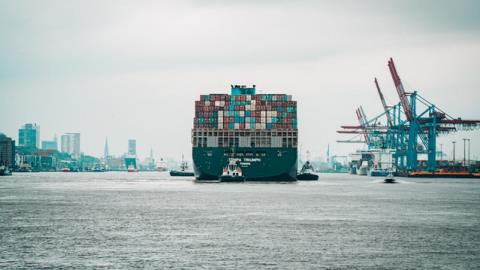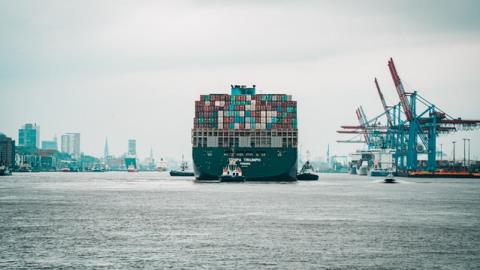In 2019, main banks and the United Nations launched the Ideas for Accountable Banking, with 130 banks collectively holding $47 trillion in property, or one third of the worldwide banking sector, signing up. In keeping with these Ideas, banks dedicated to strategically align their enterprise with the objectives of the Paris Settlement on Local weather Change and the Sustainable Growth Targets, bolstering their contribution to the achievement of each endeavours.
Nevertheless, this large quantity of capital is trickling from behind a dam created by uncertainty from lack of information, taxonomies, schemas, reporting and merchandise, which, in some way, is strong sufficient to fulfill the chance register of monetary establishments. Nevertheless, in consequence, a insecurity round viable choices for investing in sustainable initiatives permeates. The answer? Provide chain traceability – yielding dynamic, reliable, and safe knowledge from advanced provide chains – is required for buyers to ship on the promise of Environmental, Social, and Governance (ESG).
Richard Friends, contributing editor of Finextra and founding father of Accountable Danger, opened classes with an summary of the day’s proceedings and a proof of the challenges and alternatives surrounding provide chain traceability. Utilizing the palm oil provide chain for example, Friends explored related danger indicators comparable to biodiversity and local weather change and the requirement for knowledge in these areas. Additional, for mitigation and conservation to be a hit, adaptation and company disclosure is required.
To resolve these points, he went on to state that the important thing query that must be answered is: “is it doable to make use of a transactional mechanism to convey knowledge in order that it goes outdoors of non-financial reporting?” – Friends requested. Alongside this, if options comparable to carbon certificates or biodiversity certificates had been rolled into funds processes, they may change into robust incentives for monetary establishments seeking to rework their mitigation strategies for cash laundering, monetary crime, and wildlife trafficking.
Friends continued: “Then, as we transfer by means of the provision chain and the billing course of, our biodiversity and our local weather dangers change, our mitigations and variations change, and naturally the payload of information because it strikes by means of the transactional mechanism may change. That continues as we step by means of submit processing, into manufacturing and into retail.” As he elucidated, the next classes will assist attendees contemplate the totality of a provide chain.
Provide chains, the conveyor belt that convert nature into items
If the planet was a stability sheet, we’re in a loss – exploiting 1.6 instances extra Earths than we’ve got. Provide chains convert nature into items, and sometimes companies can wrestle to know the complete element of how that precisely occurs. David Cox, digital technique and accountability at Microsoft, supplied some perception into their journey and among the challenges they’re going through.
Model is a vital a part of the ESG journey. “Our mission as an organization is basically to empower each individual and organisation on the planet to realize extra,” commented Cox. For Microsoft, this seems to imply not solely serving to clients, but additionally their suppliers. There are three pillars to Microsoft’s provide chain strategy: integrity, accountability and respect.
- Integrity: being sincere, moral and reliable,
- Accountability: taking full accountability for choices, actions and outcomes, and
- Respect: recognise accountability to respect the common rights of staff in provide chains and the communities they dwell in.
These pillars are backed by expertise and transparency. Throughout his speak, Cox revealed Microsoft’s issues are usually not just for the surroundings, but additionally human rights. Cox famous that fashionable slavery is among the greatest points “we” are going through, and explored the “transparency all through our provide chain, how individuals are handled, how they’re paid the situations during which they work. The extent to which we help range and inclusion throughout the entire provide chain, not simply inside our personal organisation is basically necessary.”
Regardless of the expertise at their palms, Cox stories plenty of challenges confronted by Microsoft on this house. The primary of those is knowledge, transparency and integrity. Cox commented: “Getting data throughout our provide chain, regardless of the expertise we’ve got, is a large drawback. Whereas it might sound we’re doing a extremely nice job within the house it’s nonetheless a journey for us as properly.” One other problem is getting stakeholder alignment on what the corporate values are, and what makes them necessary. This enables them to take care of objectives and aspirations at each degree of the provision chain.
Managing danger inside the provide chain is a big a part of Microsoft’s technique. Cox mentioned that “danger isn’t just about resiliency, but additionally about elasticity.” He reiterated the significance of getting various suppliers and being prepared to maneuver to them when the necessity applies. Moreover, Cox’s view is that “local weather actually is a location challenge, and getting grip round that and relating that to your property. The suppliers and the situation of these suppliers is an issue that we’re nonetheless grappling with at the moment.” An emphasis on transparency and reporting was clear. Right here, Cox pointed to Microsoft Procurement, which not solely reveals Microsoft’s output, however is meant to be launched as a product accessible from April 2022.
Lastly, Cox showcased a few of their present reporting mechanisms. Microsoft carries out materials assessments of its gadgets, the final of those being performed in 2018 and the following one supposed to be accomplished earlier than the top of this monetary 12 months. Moreover, Microsoft voiced their engagement in reaching the UN Sustainable Growth Targets, and reporting consistent with the International Reporting Initiative Requirements.
Sourcing dependable knowledge for carbon assessments of portfolios
Presenting this Lean Again session was ODDO BHF’s Martina Macpherson, head of ESG technique and GMC committee member, who defined the significance of factoring in systemic danger throughout provide chains when making funding choices. “A holistic strategy to ESG investing should take into consideration the systemic dangers and alternatives in world provide chains linked to sourcing, tracing, due diligence and disclosure,” she mentioned.
It is a essential mission. In lower than 20 years, the ESG funding trade has swollen to a price of $35 trillion – and is estimated to hit $53 trillion inside this decade. Because of this momentum, defined Macpherson, the mandate is about for larger transparency, extra rules-based approaches, and a necessity for higher frameworks to draw and retain asset proprietor and investor curiosity.
Precisely understanding and managing ESG dangers stays a substantial problem wherever provide chains are involved, since we’re not simply speaking about direct operational impacts. As underlined by the pandemic, human rights and labour issues – in addition to local weather and environmental points – have to be factored in. All pose important challenges, not solely to operations, however to broader chains.
In keeping with Macpherson, two thirds of a mean firm’s environmental, social and governance footprint lies inside provide chains. “The monetary providers sector, in the meantime, has the very best publicity to oblique environmental results – or impacts associated to produce chain points.” It is a drawback that’s rising, versus reducing and being resolved. To make issues much more advanced, many provide chains include SMEs – most of that are ill-prepared for alignment with EU disclosure rules, as a consequence of price range and useful resource constraints. Nonetheless, “SMEs play a significant function in most economies, and symbolize 90% of companies and 50% of employment worldwide.”
There are different, extra systemic, challenges that include sourcing dependable scope 1, 2, and three knowledge for carbon assessments of portfolios. These embrace:
• Divergence of ESG definitions, methodologies and standards;
• Uncertainty round materials ESG requirements and frameworks;
• Lack of constant provide chain administration (SCM) and ESG knowledge disclosure throughout markets; in addition to a
• Lack of extensively accessible ESG knowledge units for assessing SCM dangers.
So, the place does this depart us? Clearly, a holistic strategy – from firm pre-assessments to engagement – is required, argued Macpherson. For buyers, there are three key necessities for producing ESG progress – all of that are linked to knowledge metrics and frameworks. “First, we hope to see extra profitable SCM oversight, past brief time period monetary concerns. Second, we’d like higher relationship administration with key stakeholders to ship long-term worth creation, and precisely measure corporations’ ESG dangers. Third, sustainability points should change into an intrinsic a part of buyers’ due diligence and procurement practices – particularly when sourcing buying and selling, monitoring, and reporting are involved.”
To enhance consistency, Macpherson added, the following step could be to redefine ESG evaluation methodologies, in order that they cater for environmentally and socially unethical operations throughout the complete world provide chain. “Traders and ESG scores businesses may, for example, create incentives for corporations to gather and disclose their companions’ actions.” As soon as once more, readability, consistency, and comparability of knowledge may very well be extra simply achieved if all stakeholders inside the ecosystem work collaboratively in the direction of this widespread purpose. If profitable, buyers will help be certain that the trillions of {dollars} caught behind a dam of uncertainty are allotted to the downstream initiatives which can be pivotal to saving our planet.
The ‘Bindustrial Revolution’: Topolytics’ waste administration and knowledge case examine
Michael Groves, CEO and founding father of insights supplier Topolytics, ushered the viewers into the third lean again session of the occasion, introducing his case examine round waste administration and knowledge. Monitoring and tracing stable waste knowledge is the “soiled, hard-end of the provision chain” and Groves defined that Topolytics’ core goal is round making an attempt to construct a view round what the waste system appears like on a world foundation. “We’re making an attempt to make the system extra seen, the information extra verifiable, and finally, to generate higher industrial, environmental and social outcomes round that materials.”
Contextualising the scenario, Groves noticed that the idea of waste can really be thought-about to be a provide chain in itself. Uncooked supplies are mined, sourced, then introduced into manufacturing programs which creates an “upstream” circulation of supplies then taken to manufacturing programs (with related biproducts). Then these items and merchandise are pushed out into {the marketplace} with the accompanying packaging, coming into the municipality or households, even earlier than being pushed out into the waste administration system the place we nonetheless see important quantities of waste ending up in landfill or incinerated.
The results of it is a advanced, ever-shifting provide chain with a number of supplies and gamers concerned. “What we’re making an attempt to do globally is to maneuver away from that linear mannequin the place we make items, then use them, after which throw them away, right into a extra round mannequin the place these items and supplies are stored at their highest utility.” The important thing problem of reaching this round mannequin is across the lack of visibility into the ‘downstream’ waste provide chain. There may be little or no knowledge and the belief in knowledge that’s accessible is minimal.
Sadly, this leads to over 60% of all materials going into the waste system inside cities’ city surroundings or industrial context “basically being thrown right into a gap within the floor.” On high of this, the casual waste trade additional hampers environmental efforts, whereas additionally reinforcing important social points tied to the processing and motion of waste materials. “There are nonetheless points with fashionable slavery hooked up to people who find themselves working in that system and that surroundings.”
Whereas we totally perceive the direct impression and injury that emissions immediately tied to this waste are incurring on the surroundings, Groves continued that the following step is to analyse what is going on to the waste because it strikes by means of the system. “This materials is being moved important distances generally which may very well be a results of industrial relationships that exist between corporations which can be dealing with that materials, or it may very well be associated to the place there’s capability to really course of that materials. Analysis means that 61% of the world’s inhabitants doesn’t have ready-access to recycling infrastructure. So the query is, what’s the alternative there to really do one thing completely different and enhance the outcomes for that materials?”
Explaining the advanced mixture of infrastructure that underpins the complete provide chain, Groves furthered that the websites linked to this provide chain are additionally pushing materials into the system. “So you’ve got acquired this advanced mixture of infrastructure that underpins the entire provide chain, and clearly, linked to which can be the websites which can be producing that waste within the first place by placing that materials in to the system.” These websites or producers may be categorised as each pushing materials in to the system and as websites desirous about pulling materials again in to their manufacturing programs.
Overlaid on this infrastructure is the motion of that materials. “We don’t assume we are able to divorce the mapping of waste materials from what occurs to waste materials. We should contemplate the impression the motion of waste bears on the method too.” The motion consideration hooked up to waste is totally important to understanding what have to be modified inside the complete waste system. “By way of the environmental carbon impacts of great actions of fabric over important distances, we pull these two issues collectively. That is how we begin to attempt to construct an image of what is taking place throughout that system.”
Trying on the knowledge itself, Groves added that whereas the waste administration trade is much like most different industries in that it has been uncovered to important applied sciences, sadly the prevailing knowledge sources accessible are databases and spreadsheets. These are very guide approaches and with the intention to unpick and perceive what’s going on, Groves argued that we’ve got to have the ability to handle knowledge even on this difficult type.
Inside this world, there are classification schemes round how supplies are outlined which differ throughout international locations, jurisdictions and firms. “There may be actual complexity round the way in which that materials is being outlined and measured, and the way knowledge is being collected. So on one hand, you’ve got acquired a really guide, conventional type of knowledge assortment system.”
Nevertheless, Groves continued {that a} shift is rising towards machine primarily based knowledge assortment. No matter this development, he doesn’t imagine there’s one single knowledge assortment mechanism that can give a complete view throughout the trade on a world scale which assesses the downstream provide chain successfully. “We have to have the ability to pull in knowledge from many various sources. We’re beginning to see robotics and machine imaginative and prescient programs getting used to assist kind that materials, automating the sorting completely different plastics and polymers for example.”
The “web of bins” or “bindustrial revolution” is seeing the expansion of bins with sensor expertise in order that native authorities can higher handle the system, whereas digital deposit returns with sensible labels are linking waste and recycling efforts to the blockchain. But, as a result of these programs are removed from ubiquitous, Groves said that we should be capable of pull knowledge from this eclectic and disparate sources of knowledge, to construct a greater, extra truthful image of the system.
“When enthusiastic about the downstream waste system, the satan is within the element. We have to get extra granular, extra comparability, reference-ability and high quality when it comes to the information we’ve been capable of feed into ESG metrics to have the ability to sew the entire accessible metrics collectively.”
Click on right here to register for the Sustainable Finance Stay workshops.
,Sustainable Finance Stay is again for one more digital occasion. Finextra and Accountable Danger have come collectively for a thought-provoking collection of experiential occasions, welcoming banking and expertise ecosystems to collaborate on enabling a wave of change.,








